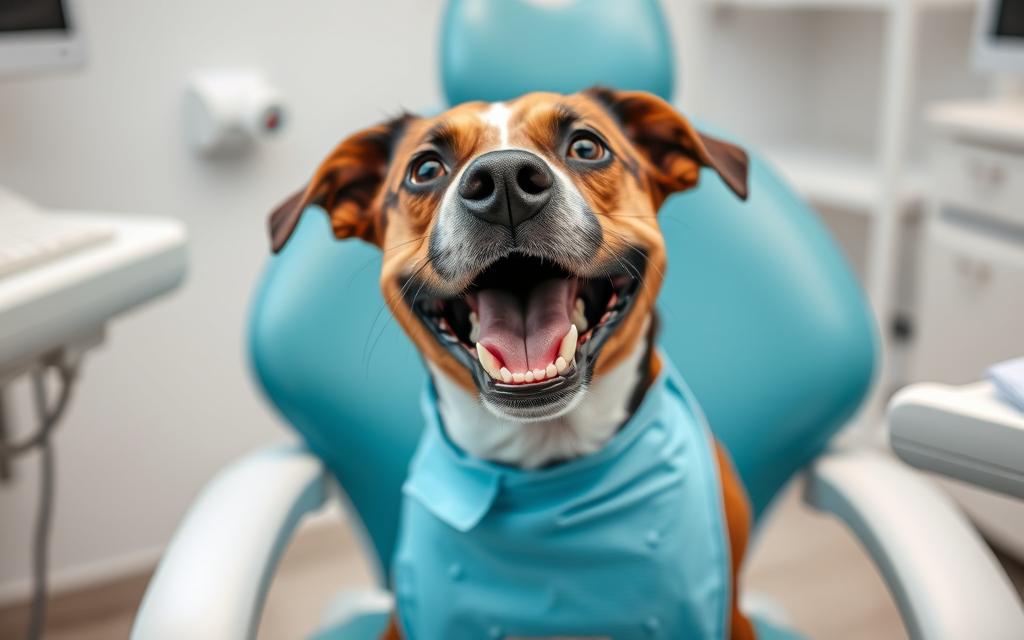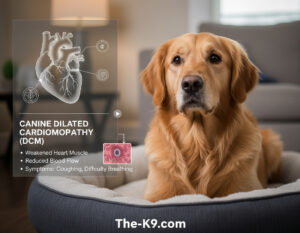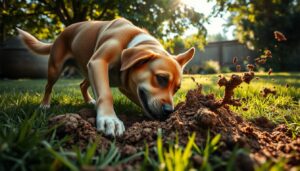
How to Clean Dogs Teeth without Anesthesia : Easy Tips for Owners. Did you know that 80% of dogs get periodontal disease by 3 years old? Keeping your dog’s teeth clean is very important. Luckily, there are safe ways to do this without anesthesia. Anesthesia-free teeth cleaning is becoming popular. It’s a gentle way to keep your dog’s mouth healthy, especially for older dogs or those with health problems.
Key Takeaways: How to Clean Dogs Teeth without Anesthesia : Easy Tips for Owners
- Anesthesia-free teeth cleaning is a safe, non-invasive option for keeping your dog’s teeth clean.
- It involves trained dental technicians scraping above and below the gum line to remove plaque and tartar.
- This approach can be suitable for senior pets or animals with health issues that make anesthesia risky.
- Anesthesia-free cleaning is about one-third the cost of cleanings done under anesthesia.
- It’s important to complement anesthesia-free cleanings with regular veterinary dental care for more serious issues.
- Importance of Regular Dog Teeth Cleaning
- Tools Needed for Cleaning Dogs Teeth at Home
- Strategies for Brushing Your Dog's Teeth
- Benefits of Anesthesia-Free clean dogs teeth Cleanings
- Concerns Regarding Anesthesia-Free Cleanings
- Professional Dog Teeth Cleaning Under Anesthesia
- At-Home Dog Dental Care Routine
- FAQ
Importance of Regular Dog Teeth Cleaning
Keeping your dog’s teeth clean is key to avoiding tooth loss, pain, and even organ damage. Dogs can get periodontal disease as young as 3 years old. This can cause loose teeth, gum problems, and spread harmful bacteria to the heart, kidneys, and other organs.
Preventing Tooth Loss and Oral Pain
Without yearly cleanings, plaque builds up, causing bad breath, gingivitis, and periodontal disease. Regular brushing and dental products are essential for your dog’s oral health. Dental chews, food, or treats can also help prevent plaque.
Stopping Organ Damage from Plaque Bacteria
Periodontal disease can lead to heart disease if bacteria from the mouth gets into the bloodstream. Dogs with poor dental care are at higher risk of heart disease and organ failure. Regular teeth cleaning can greatly reduce dental disease risk, improving heart health and potentially increasing lifespan.
Regular teeth cleanings, whether done without anesthesia or under it, can catch dental problems early. Veterinary cleanings, which include a detailed examination and treatment, are recommended yearly. Dogs prone to dental issues may need more frequent visits.
Tools Needed for Cleaning Dogs Teeth at Home
Keeping your dog’s teeth clean at home is easy with the right tools. You can prevent plaque, tooth decay, and other dental problems. Here are the key items to keep your dog’s teeth clean and their smile bright.
Dog-Specific Toothpaste
It’s important to use toothpaste made for dogs. Human toothpaste can be dangerous if your dog swallows it. Dog toothpaste comes in tasty flavors like chicken, beef, or pork. These flavors make brushing your dog’s teeth a fun experience.
Soft-Bristled Toothbrush or Finger Brush
A soft-bristled toothbrush is best for dogs. It gently removes plaque and tartar. You can also use a finger brush, which fits over your finger. It gives you better control and reaches hard spots in your dog’s mouth.
Rubber Gloves
Rubber gloves are very helpful when brushing your dog’s teeth. They protect your hands from drool and nips. They also make it easier to hold the toothbrush or finger brush.
With these tools, you can keep your dog’s teeth clean at home. Regular brushing and occasional vet visits are key. They prevent expensive dental problems and keep your dog’s mouth healthy for a long time.
Strategies for Brushing Your Dog’s Teeth
Cleaning your dog’s teeth is key for their health. But, it can be tough if you don’t know how. Make it comfy and fun for your dog. Start with the front teeth and move to the back molars. Brush down for 30 seconds to a minute on each side.
Brushing Technique and Duration
Vet Angelica Dimock, DVM, says clean teeth are good for dogs. They help with less anesthesia, lower bacteria, and less mouth inflammation. Brushing daily is best, but even weekly or bi-weekly helps a lot.
Getting Your Dog Comfortable with Teeth Cleaning
It’s important to make your dog feel at ease with teeth cleaning. Start slow and use treats and praise to make it fun. Puppies learn faster, so start early.
Some dogs might not like it, and you might need to hold their mouth or get help. If they hurt or bleed too much, see your vet. It might mean they need a professional cleaning.
Benefits of Anesthesia-Free clean dogs teeth Cleanings
Anesthesia-free dog teeth cleanings have many advantages. The main benefit is that they don’t use medication or anesthesia. This makes them safer and more convenient, especially for dogs with health problems.
No Medication or Anesthesia Required
Unlike traditional dental cleanings, these procedures don’t need general anesthesia. This is great for senior dogs or pets with health issues. It’s safer for them because they don’t have to go under anesthesia.
Short Procedure Duration
These cleanings are quick, usually taking less than an hour. This short time reduces stress and discomfort for the pet. It’s more comfortable than the long, anesthetic cleanings.
Suitable for Pets with Health Issues
Pets with anxiety or health concerns can benefit from these cleanings. They don’t need sedation and are shorter. This makes them a better choice for dogs that can’t handle traditional anesthetic cleanings.
In summary, anesthesia-free dog teeth cleanings are safer, more convenient, and suitable for more pets. This makes them a popular choice for many dog owners.
Concerns Regarding Anesthesia-Free Cleanings
Anesthesia-free teeth cleanings are seen as a convenient and affordable option for pet owners. Yet, some veterinarians have concerns about their effectiveness. They worry that dental technicians might not be trained well enough to do a thorough exam or spot health issues.
Without anesthesia, cleaning below the gum line and tackling deeper dental problems becomes a challenge. This makes it hard to ensure a complete cleaning.
Effectiveness Concerns from Veterinarians
The American Veterinary Medical Association, American Animal Hospital Association, and the American Veterinary Dental College advise against non-anesthesia teeth cleaning for pets. They say it can’t remove all tartar, and plaque and tartar will come back fast. Pets may also feel stressed and could get hurt from sharp dental tools.
Standardized Training and Certification
To tackle these issues, there’s a need for standardized training and certification for anesthesia-free cleanings. The American Veterinary Dental College has fought against anesthesia-free dentistry for dogs and cats. They’ve even launched a website for pet owners and professionals.
Despite this, more pet owners are choosing anesthesia-free dentistry. They’re worried about anesthesia risks and it’s becoming more common through general practitioners.
| Concerns about Anesthesia-Free Dog Teeth Cleaning | Limitations of Non-Anesthetic Dental Cleanings | Training and Certification for Anesthesia-Free Dog Teeth Cleaning |
|---|---|---|
| Veterinarians worry about the effectiveness of anesthesia-free cleanings, the ability to perform thorough exams, and identify underlying health issues. | Non-anesthetic cleanings cannot remove all tartar, and plaque and tartar will return quickly. Pets may experience stress and risk injuries from the procedure. | Standardized training and certification programs are needed to ensure a consistent level of care in anesthesia-free cleanings. |
Professional Dog Teeth Cleaning Under Anesthesia
For dogs with serious dental problems, a professional teeth cleaning under anesthesia is often needed. This method lets a skilled vet dental specialist clean below the gum line. They remove plaque and tartar, which can cause periodontal disease.
Deep Cleaning Below the Gum Line
This cleaning process allows the vet to reach hidden areas of the teeth. It’s crucial for treating problems that aren’t seen in a basic cleaning.
X-Rays and Dental Treatments
During the cleaning, X-rays are taken to check the teeth roots and jawbone. These images help spot and fix any dental issues that need extra care, like extractions or restorations.
Veterinary Dental Specialists
Experienced veterinary dental specialists perform these cleanings. They have advanced training in dog oral health. They can handle complex dental needs, ensuring your dog gets the best care.
This more detailed cleaning is vital for dogs with serious dental issues. It tackles problems below the gum line and uses X-rays. This helps prevent long-term dental problems and keeps your dog’s teeth healthy for a long time.
| Procedure | Description | Benefits |
|---|---|---|
| Professional Dog Teeth Cleaning Under Anesthesia | A thorough cleaning performed by a veterinary dental specialist, with the dog under general anesthesia. |
|
At-Home Dog Dental Care Routine
Between professional teeth cleanings, you can help your dog at home. Brushing their teeth daily with dog-safe toothpaste is key. You can also use dental chews, wipes, or sprays with probiotics to fight bacteria.
Feeding your dog a raw, whole-food diet with meaty bones helps remove plaque. This is because chewing and gnawing on these bones naturally cleans their teeth.
Combining at-home care with occasional professional cleanings keeps your dog’s mouth healthy. Small-breed dogs need extra care because they’re more prone to dental disease. Dogs with food allergies should choose toothpaste flavors carefully to avoid allergic reactions.
Brushing your dog’s teeth 2-3 times a week is a good start. Brushing every day is even better. Prescription dental foods, like Purina ProPlan Veterinary Diets DH Dental Health, can also help. The Veterinary Oral Health Council’s Seal of Acceptance on dental treats shows they’re effective in controlling tartar.











